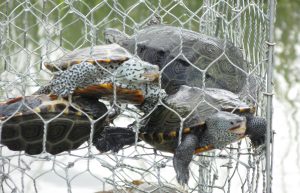
Diamondback terrapins found alive inside this crab pot will be released. Photo courtesy Timothy Russell
By Cindy Hoffman, Staff Writer
(March 30, 2023) Crabbing season is almost here. That’s great news for crab lovers, but not so great for Maryland’s state reptile, the diamondback terrapin.
Diamondback terrapins are aquatic turtles that were once plentiful but today are struggling to survive, largely because of the human presence: their greatest threat is drowning in crab pots.
“Crab pots don’t kill crabs, because crabs don’t need air,” Sandi Smith, outreach and marketing coordinator for the Maryland Coastal Bays Program said. “But they do kill turtles. Once the turtle gets inside the crab pots, they can’t escape and drown.”
Terrapins are drawn into crab pots by the same bait crabbers use to attract blue crabs. However, unlike blue crabs, terrapins must rise periodically to the surface for a breath of air. Terrapins trapped in a fully submerged crab pot will eventually drown.
“Most recreational crabbers don’t realize that it is illegal to use a crab pot without what is called a “bycatch reduction device” or BRD.” Smith said. “It’s not a new law, just an unknown law and one that is hard to enforce.”
The law, which was passed in 1999, requires each entrance to a crab pot be equipped with a BRD.
Waterfront property owners are legally allowed to crab with a maximum of two recreational crab pots, but they must register through the Maryland DNR for a free license.
The BRD is pretty simple; it is a rectangular piece of metal or thick 11-gauge galvanized wire that is too small for a mature turtle to get through to enter the crab pot (1 3/4 inches by 4 3/4 inches). This keeps out adult turtles, but easily allows even the biggest crabs to enter.
“When one [turtle] gets trapped in a pot, it starts to panic, which attracts others into the pot,” Smith said.
Without the BRDs, more than just diamondback terrapins can get stuck in the crab pots. Smith has seen otters and even raccoons stuck in the crab pots as well.
Ghost crab pots (a pot that has lost its float) are a real issue. “Recreational boaters may run over a buoy and the crab pot will sink to the bottom,” Smith said. “It’s the gift that keeps on killing.”
Maryland Coastal Bays Program works with watermen in the winter to locate and remove ghost crab pots.
“Local places like Elliott’s Hardware sell crab pots with BRDs,” Smith said. “But crab pots at Walmart don’t, although they are amenable to having volunteers put the BRDs on the pots in the store.”
Commercial crabbers do not need to use the BRDs because they monitor their crab pots daily and can therefore release the turtles fairly quickly.
The diamondback terrapin is currently under consideration as a species of concern by the U.S. Fish and Wildlife Service. Its habitat is brackish waters in the bays and creeks of the Atlantic and Gulf coasts. It’s the only turtle in North America restricted to estuaries.
Terrapins provide high quality food for many species. They also control numbers of periwinkle snakes which, left unchecked, can damage marshes, and they clean the bay bottom by consuming dead estuarine organisms.
Crabbers can get free BRDs from the Maryland Coastal Bays Program. Contact Sandi Smith at sandis@mdcoastalbays.org.
Smith will be at the Ocean Pines Fishing Flea Market on April 22 with an education booth and free BRDs.
